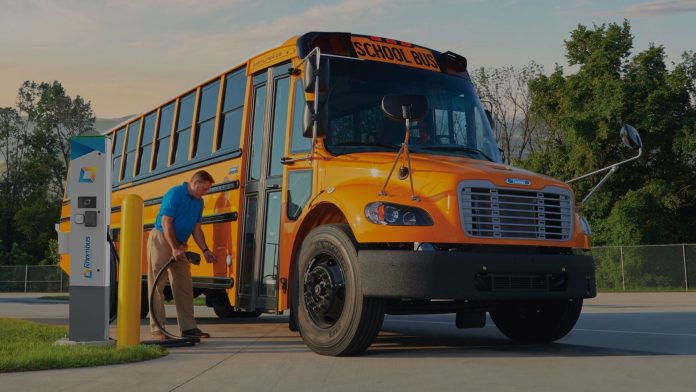The future of EV infrastructures will include Vehicle to Grid (V2G) capabilities using bi-directional chargers to reduce the cost of fleet ownership and improve grid stability.
Fleet vehicles like school buses are uniquely suited to V2G applications due mainly to predictable usage patterns and the fact that they often return to base at the end of the working day, where they sit idle overnight. Regular charging patterns provide the perfect condition for V2G applications by allowing the use of stored energy during specific periods while planning enough time to charge vehicles again for the next day. This will be a crucial feature for reducing the cost of fleet ownership by enabling fleets to sell energy, including from renewable sources, back into the grid.
Financial Impact
V2G takes the unused energy in an EV’s battery, puts it back onto the grid during peak demand hours, and then recharges the vehicle during off-peak hours (typically 9 p.m.-9 a.m.). The energy put back onto the grid during on-peak time of use (TOU) hours allows the vehicle operator to get a premium for that energy and recharge at cheaper rates.
As an example of potential cost savings, San Diego Gas & Electric (SDG&E) charges less than $0.24 per kWh during super off-peak TOU and almost $0.60 per kWh during on-peak TOU, double the price (prices from June 1, 2022, Time-of-Use Plans).
The impact of V2G on electric vehicle fleet energy costs can be substantial, but the impact on the choice of EV charging infrastructure is also noteworthy. Incorporating V2G essentially reduces the vehicle’s charging window and increases the vehicle’s charging time.
This is because both the energy used by the vehicle and the energy put back onto the grid during peak hours must be recovered to charge the vehicle fully. Maximizing infrastructure uptime is critical for a successful implementation. Considerations for selecting capable electric vehicle supply equipment (EVSE) for a V2G infrastructure are listed further in this article.
Grid Resilience
Both extreme weather and peak loads constantly challenge the utility grid’s resilience. Recent events underline the need for backup power storage, such as Hurricane Katrina, Hurricane Ida, Hurricane Sandy, Hurricane Sally, the Texas cold snap of 2021, and the extreme heatwave of 2022. Power outages during these events reveal vulnerabilities of our emergency power systems which can be critical hospitals, nursing homes, and other healthcare facilities. The potential power available from EV fleets can help manage disruptions as they unfold and mitigate the impact of power outages on communities.
Utilities realize V2G potential for adding grid stability and are implementing incentives for fleets. For example, Pacific Gas & Electric (PG&E) is planning to pay up to $2 per kWh for emergency use.
V2G Infrastructure Considerations
Fleet operators must consider several factors when planning a V2G-capable charging infrastructure. Equipment is the first consideration. Fleets must be equipped with vehicles and Electric Vehicle Supply Equipment (EVSE) that support bidirectional charging. Operators will need UL 1741-SA certified Level 3 DC fast chargers (DCFC), such as Rhombus RES-DCVC125-480 chargers and RES-D3-CS20 dispensers, which run on 480 3-phase power.
Fleet operators should also reach out to a utility rep to find out about any potential upgrades that may be required because of the new loads from EVSE, such as a new service line or an upgraded distribution transformer. Your local utility may offer EVSE rebates to reduce the capital cost, so it’s important to contact a rep early in the V2G infrastructure planning process.
Other considerations include determining site layout, future planning, and steps to mitigate installation costs.
Partner with the experts and let Rhombus design an ideal V2G infrastructure to meet your needs. Get started here.


















